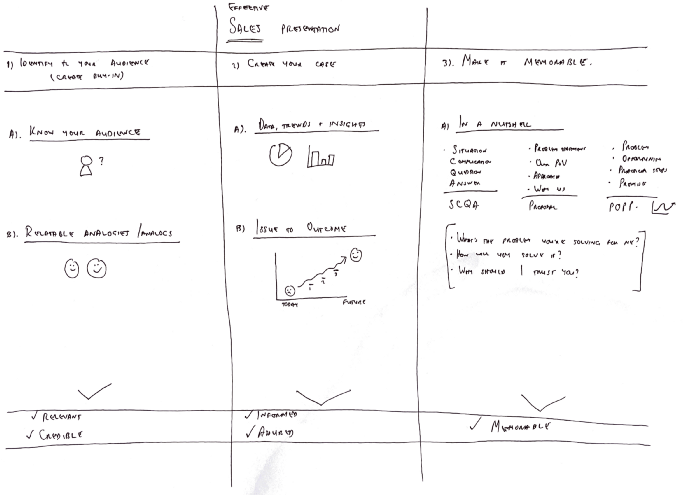Effective Sales Presentations

As a management consultant, a key part of success is the ability to sell. Not in the sense of ‘sell me this pen’ (a la Wolf of Wall Street), but to sell in the idea, the relevance, the credibility of the service you can provide in response to a client’s challenge.
In approaching this task, I’ve always been inclined to distil my thinking onto a single page — to see if I have the complete a complete picture. A good proposition needs to be relevant (to the audience’s need), credible (based on your capabilities and experience), distinct (from the competition) and desirable (to the recipient).
There are numerous ways to frame the story, and part of what makes your story relevant, credible, distinct and desirable is choosing the right ‘ingredients’ and blending them in the right order to make a compelling sales pitch (I use the word pitch loosely).
During my 15 year career, it helps to identify these common ingredients, and the general structure in which to apply them.
Part 1: Identify with your audience
Your first step is to know your audience and show that you understand them. You need to show how you understand their problem, through their eyes. Then you need to establish why you have credibility / authority to be in the room to help them address this problem.
With these two things, you set the stage for a relevant (i.e. why should I listen to you) and credible (i.e. why should I trust you) discussion.
Two elements that can help achieve this:
a. Know your audience: at the business level. What is their problem, what are they trying to achieve, what have they done, why are they asking for help now? At a personal level — what is this person looking for? what is their style? what are they looking to gain from this experience?
b. Share relatable analogies / analogs that they identify with: show how you’ve helped people in similar positions with similar challenges. Or share a poignant / provocative point of view in this area that gets the client to sit up and pay attention to what you have to say on this topic.
Part 2: Present your case
Part 1 establishes your relevance and credibility in the room, and hopefully makes you relatable to the client / prospect. Step 2 presents your case i.e. what data have you selected to shed light on the problem / approach / solution, and what is your view on how you will help them move from issue (where they are today) to desired outcome (where they want to be in future).
With these two things, you show that your case is informed (i.e. it is data-driven and robust) and that your case is clear and pragmatic (i.e. provide the client with assurance, clarity and confidence on what needs to be done).
Two elements that can help you achieve this:
a. Present data & insights: show relevant data, trends and insights on the challenge they are facing. Show that you understand the context, extent and causes behind the problem. But also use it to present the opportunities (e.g. benchmarks) of others that have solved for these problems.
b. Show the journey; from ‘Issue to Outcome’ or from ‘Here to There’: every project / solution is a journey to take the client from where they are today (the issue) to a desired place in the future (the outcome). Along the way, there needs to be some level of clarity on the key steps / phases to achieve this (also knowing the journey is never a straight-forward plan).
Part 3: Make it memorable
So you’ve identified and related to your client, you’ve peaked their attention with why they should listen to you, and you’ve illustrated the journey from ‘here to there’ clear, pragmatic and data-driven.
Now you need to ensure they remember what you’ve just told them after you leave!
You need to capture what you’ve said in a succinct and memorable way. Ultimately you are trying to capture the answers to these questions in a nutshell:
- What is the problem you are solving for me? (have you clearly understood and articulated my problem? Have you shed light on the root cause in a way I had not considered?)
- How will you solve it? (have you given me confidence that you know what needs to be done, but also shown you are not rolling out a cookie cutter approach and not assuming you know everything about me before we have even started working together?)
- Why should I trust you? (have you demonstrated your credibility, experience, expertise, proven impact in the space I am asking you to operate?)
There are a few frameworks to recap your ‘elevator pitch’ that I’ve used:
a. SCQA: Situation, Complication, Question, Answer
b. Proposal: Problem statement, POV, Approach, Credentials.
c. POPP: Problem, Opportunity, Practical Steps, Promise.
I hope the above is a useful framework to inform / prompt your thinking in creating an effective sales presentation. As always I’d love to hear further thoughts.